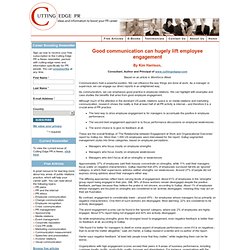

Does your Internal Communication team add value in the right places? When organisations think through their internal communication function they sooner or later have to ask where they add the most value and whether it is enough to be a great writer or organiser.

Research that I did with Sue Dewhurst in the past highlighted the fact that whilst a good communicator needs certain basic skills, they are just that – basic. In order to have an impact, professional communicators need to do much more. So where does an internal communicator add value? Whilst each individual step in the process is important, it is only when you have thought about the whole end-to-end value chain can you decide where best to focus your effort. Why internal communication matters - Across Technology. Good Communication Counts. Here’s Why… Is Communication Important For Employee Productivity? (Infographic) When we talk about business communication, we want to achieve the following three results: No. 1: Improving liaisons with your customers.

When you communicate well within your organization, there are higher chances that you project yourself well to your customers, listen to their problems well and provide them with an apt solution. No. 2: Educating all employees about your goals. The time you are well versed with what you need to do, it’s time that you share your work and discuss it with other people in your organization. This will provide you with a clear picture about their thought processes and you might just get rich insights from them. No. 3: Growth. What is Internal Communication? Definition by Melcrum. What is Internal Communication?

Why do you need it? How do you create it? The Ultimate Customer Experience Infographic, 2014. In honor of Customer Experience Day, Temkin Group created its second annual “The State of Customer Experience” infographic.

You can see a vertical infographic below or: Here are links to the research referenced in this infographic: Here’s a link to last year’s infographic. Investing in internal communication: Will it be profitable? Zyncro Blog: the blog of the Enterprise 2.0. Estimated reading time: 5 minutes Internal communication should have a budget allocated to it like any other important business area; nonetheless, it usually does not.

Internal communication doesn’t get the necessary financial resources assigned to it and for many it is deemed a murky investment. Communicating to achieve results is anything but frivolous. Posted on September 2, 2014 6:18 pm by Shel Holtz | Internal | Politics | Publishing In the business world, communication plays a big part in engaging employees.

There is ample research that proves companies that communicate well are four times more likely to have engaged staff. This matters because engaged employees are more efficient and productive. Turnover is lower among engaged employee populations. Motivation levels are higher. In the business world, that’s worth the cost because the payoff is so much greater. That, at least, seems to be the thinking behind an attack by Rep. Those items include some fairly routine internal communication tactics. In-effective Internal Communication Costs. Why it pays to keep employees in the loop. Avoid communication breakdown: Messages from key leaders should serve to constantly remind and refresh staff as to the organisation's direction and goals so that staff feel they are striving towards a common goal.

Most organisations spend a small fortune developing and distributing external marketing and other messaging to the customers and external stakeholders. Meeting Cost Calculator. Improve employee engagement: engage with social media. Numerous research studies have shown that engaged employees are the basis of a company's success and drive tangible performance results.

Their contribution is particularly essential during a lengthy period of economic recession: engaged employees have a genuine intellectual and emotional sense of ownership and are willing to do whatever is needed to support the organisation's success. They take pride in doing so, and thereby acquire individual job satisfaction. Social media is an intrinsic component of how we live and work, and more and more companies are recognising social media and social networks as valuable tools for refining employee engagement, communicating their business strategy across the board, and measuring impact.
Between 2009 and 2010, social networks traffic increased by 43% (Nielsen study) - and today, social networks are the primary activity. Engagement matters. Employee Engagement. Can Internal Communications Impact the Bottom-Line? « INTRASKOPE – INTERNAL COMMUNICATION VIEWPOINT FROM INDIA. I came across an interesting question on Linkedin by a communication professional in the Russian Federation seeking inputs on how ‘internal communications affects business results (in terms of money)’.

He goes on to explain his situation – “IC is a new function in our company. I need to prove expenses to Board Members. I understand that communications is not the only thing that builds business result. Good communication can hugely lift employee engagement. By Kim Harrison, Consultant, Author and Principal of www.cuttingedgepr.com Based on an article in Workforce Week Communicators hold a powerful position.

We can influence the way things are done at work. As a manager or supervisor, we can engage our direct reports in an enlightened way. How do internal communication strategies affect employee performance in large corporates? May 2, 2012 “A close-tie between business, performance technology and communication strategies will focus understanding and support for the direction of the organisation. Change Management and Communication 2011-2012 Study. Poor Internal Communications: Why Many Leaders Lose Touch. Failure of internal communications is the main reason leadership teams lose touch with employees, according to a survey of more than 300 executives and managers conducted by AMA Enterprise, a division of American Management Association. One-third of those surveyed reported that their organization’s senior team operates within a “leadership bubble” most of the time, while half indicated it occurs at least on occasion. Just 18% said their leadership has not, to some degree, lost touch with the organization.
Moreover, three-quarters of respondents said they had worked at an organization where the leadership team seemed to carry on as though it was stuck in a bubble. When asked the main cause of the problem a majority of the respondents cited poor internal communications or the corporate culture. 32% Failure of internal communications 28% The corporate culture 23% Too many “yes” men and women advising the CEO 16% Personality of the CEO The survey was conducted March 8 to March 24, 2014.
2012 Edelman Trust Barometer: Executive Summary. SHRM 2010 Employee Job Satisfaction Report: Don’t Forget the Individual Perspective. The Society for Human Resource Management just posted its annual look at the factors that drive employee satisfaction in the workplace. One unique element of the SHRM research is that it looks at the factors from two perspectives—employees and HR professionals.
First time readers of the report will be surprised that the lists of what employees want from the workplace and the list of what HR professionals perceive they want do not match up exactly. But in reality, it makes perfect sense, because each group perceives the environment a little differently depending on their experience. Let’s take a look at the two rankings in this year’s report, identify the differences, and explore what it means for leaders in today’s organizations.
First, the employees’ ranking Job securityBenefitsOpportunities to use skills and abilities Next, the HR professionals’ ranking Relationship with immediate supervisorJob securityCommunication between employees and senior management. About That $100 I Owe You. Human Resources is often charged with the tasks of improving employee morale, human capital management, eliminating negativity, and developing employee engagement often for the entire organization.
And depending on the size of your organization and where your offices are geographically located, this can be a tall order not only for human resources but the managers and leadership you are indirectly responsible for managing this task day to day. According to John P. Employees: The Missing Link for a Robust Corporate Brand. Before I became a public relations practitioner in the “agency” world, I worked for a Fortune 500 company as an employee communications specialist. Fast forward a few decades (just a few) and I’ve observed that employee communications essentials remain the same even though the channels companies use to deliver news internally are vastly different. Intranets, Facebook, blogs, email and even Twitter have made employee communications so much more fluid and dynamic.
CEOs have embraced the roles of Chief Information Officer and Chief Marketing Officer and now see themselves as an integral part of the corporate brand. Employee communications is recognized by C-suites everywhere as an important piece of the corporate fabric. Gone are the days of the paternalistic organization, where the only voice heard was that of the CEO. Yet employees are still vastly under-utilized as valuable communications resources. I actually had a rare but wonderful customer experience recently. 5 reasons every business needs good internal communication. Why great teams and great companies are built on great communication. State of the Global Workplace 2011. Why great teams and great companies are built on great communication.